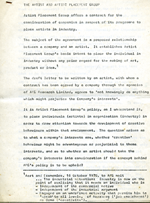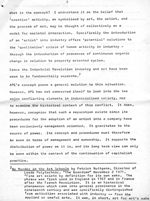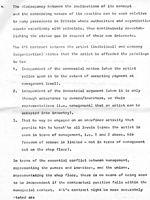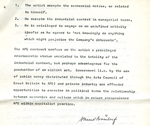



THE ARTIST AND ARTIST PLACEMENT GROUP
Stuart Brisley
published in Studio International 1972
Artist Placement Group offers a contract for the consideration of companies in respect of its programme to place artists in industry.
The subject of the agreement is a proposed relationship between a company and an artist. It establishes Artist Placement Group's basic intent to place the individual in industry without any prior regard for the making of art, product or idea (1).
The draft letter to be written by an artist, with whom a contract has been agreed by a company through the agencies of APG Research Limited, agrees to ‘not knowingly do anything which might prejudice the Company’s interests’.
It is Artist Placement Group’s policy, as I understand it, to place individuals (artists) in organisation (industry) in order to draw attention towards the development of creative behaviours within that environment. The question arises as to what a company’s interests are, whether ‘creative’ behaviour might be advantageous or prejudicial to those interests, and as to whether an artist should take the company’s interests into consideration if the concept behind APG’s policy is to be upheld?
What is the concept? I understand it as the belief that ‘creative’ activity, as symbolised by art, the artist, and the process of art, may be thought of collectively as a model for societal interaction. Specifically the introduction of an ‘artist’ into industry offers ‘potential’ solutions to the ‘qualitative’ crisis of human activity in industry – through the introduction of processes of continuous organic change in relation to property oriented cycles.
Since the Industrial Revolution industry and art have been seen to be fundamentally separate (2).
APG’s concept poses a general solution to this situation. However, APG has not concerned itself to look into the two major conflicting elements in industrialised society, nor to examine the historical context of this conflict. It does, however, recognise that such a separation exists since its procedures for the adoption of an artist into a company have been exclusively management oriented. It gravitates to the source of power. Its concept and procedures must therefore be seen in terms of management and ownership. It supports the distribution of power as it is, and its longterm view can only be seen within the context of the continuation of capitalist practice.
The discrepancy between the implication of its concept and the conserving nature of its practice can be seen relative to many precedents in Britain where authorities and organisations equate expediency with principle, thus continuously re-establishing the status quo in respect of their own interests.
The APG contract between the artist (individual) and company (organisation) states that the artist be afforded the privilege to be:
1. Independent of the commercial motive (when the artist relies upon it to the extent of accepting payment at management level).
2. Independent of the industrial argument (when it is only through acceptance by owners/investors, or their representatives (i.e. management) that an artist can be accepted into industry).
3. That he may be engaged on an undefined activity that permits him to ‘speak’ to all levels (since the artist is seen in terms of management, i.e. 1 and 2 above, his freedom of access is limited – not in terms of management but on the shop floor).
In terms of the essential conflict between management, representing the owners and investors, and the unions, representing the shop floor, there is no means of being seen to be independent if the contractual position falls within managerial context. APG’s contract might be more accurately stated as:
1. The artist accepts the commercial motive, as related to himself.
2. He accepts the industrial context in managerial terms.
3. He is privileged to engage on an undefined activity insofar as he agrees to ‘not knowingly do anything which might prejudice the Company’s interests’.
The APG contract confers on the artist a privileged aristocratic status unrelated to the totality of the industrial context, but perhaps advantageous for the production of an elitist art. Government (i.e. by the use of public money distributed through the Arts Council of Great Britain to APG) and private industry are afforded opportunities to exercise in political terms the relationship between economics and culture which in return encapsulates APG within capitalist practice.
-------------------
Footnotes
(1) Art and Economics, 16 October 1970, to APG noit
… The industrial situation: Industry is now on the point of realising that it needs and individual who is
- Independent of the commercial motive
- Independent of the industrial argument
- Engaged on an undefined activity that permits him to ‘speak’ to all levels. of Herzberg (‘job enrichment’) de Bono (‘creativity’).
(2) No Murder in the Art Schools by Patrick Nuttgens, Director of Leeds Polytechnic. “The Guardian” November 2 1971.
“Fine art exists by definition for its own sake. The phrase was first used in England in 1767 and in France after the French Revolution. It is an historical phenomenon which came into general prominence in the nineteenth century and was specifically distinguished from activities associated with industry –– from the applied or useful arts. It was, in short, art for art’s sake.”